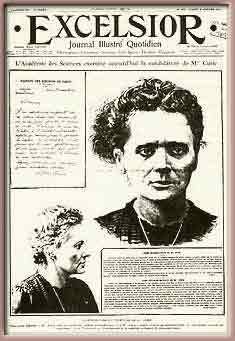 |
| The right-wing French press,
including the daily Excelsior, attacked Curie's candidacy
for the French Academy with scurrilous and racist claims based
on supposedly scientific analyses of her handwriting and facial
characteristics. |
|

 The Academy Debacle
The Academy Debacle
 SCANDAL-DRIVEN PRESS is not a recent phenomenon. Pierre and
Marie had been hounded by intrusive reporters as early as 1902,
when news began to circulate about the medical uses of radium. After
they won the Nobel Prize, reporters redoubled their attentions.
But until late 1910 most press coverage of Marie Curie focused on
the heroic labors of the blonde, foreign-born mother, wife, and
then widow. Some of the press changed its tune, however, in November
1910, when Curie offered herself as a candidate for the single vacant
seat for a physicist in the French Academy of Sciences.
SCANDAL-DRIVEN PRESS is not a recent phenomenon. Pierre and
Marie had been hounded by intrusive reporters as early as 1902,
when news began to circulate about the medical uses of radium. After
they won the Nobel Prize, reporters redoubled their attentions.
But until late 1910 most press coverage of Marie Curie focused on
the heroic labors of the blonde, foreign-born mother, wife, and
then widow. Some of the press changed its tune, however, in November
1910, when Curie offered herself as a candidate for the single vacant
seat for a physicist in the French Academy of Sciences.
Her main rival for the seat was 66-year-old Edouard Branly, whose
scientific reputation was based on his contribution to wireless
telegraphy. When Italian Gugliemo Marconi was awarded the 1909 Nobel
Prize for Physics for his work in that field, many French patriots
felt stung by Branly's exclusion.
|
|
Branly's claim to
the Academy chair was also championed by many French Catholics,
who knew that he had been singled out for honor by the Pope. For
generations French politics had been bitterly divided between conservative
Catholics and liberal freethinkers like Marie and her friends, and
the split ran through every public action.
Among the false rumors
the right-wing press spread about Curie was that she was Jewish,
not truly French, and thus undeserving of a seat in the French Academy.
Although the liberal press came to her defense, the accusations
did the intended damage. Branly won the election on January 23,
1911, by two votes. Curie responded to the snub characteristically,
by throwing herself into her work.
|
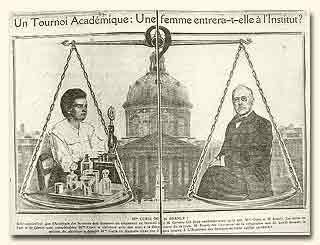 |
| “An academic tournament:
Will a woman enter the Institute?” Marie was weighed
against Edouard Branly, who taught at a leading Catholic institution.
|
|
“The struggle between you and M. Branly will arise most strongly
on the clerical issue....Against him will be the forward-looking
and university elements of the Academy....” --letter
from Georges Gouy to Marie Curie, November 1910
|
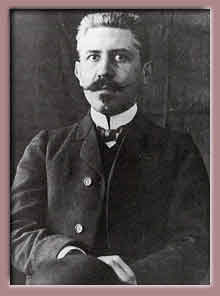 |
| Paul Langevin. The Langevins' 1902 marriage had deteriorated
to such an extent by mid-July 1910 that Langevin left the family
home for an apartment in Paris, not far from Curie's lab. |
|
 The
Langevin Affair
The
Langevin Affair
 N
EVEN WORSE SCANDAL was to erupt before the end of 1911. That
a woman who was left a widow at 38 should become romantically attached
again is not surprising. But when Curie's relationship with fellow
physicist Paul Langevin moved beyond friendly collegiality to mutual
love, she could not foresee where it would lead. Langevin, a brilliant
former pupil of Pierre's, was unhappily married to a woman who came
from a similar working-class background but lacked his educational
attainments. With four children to raise, Madame Langevin complained
that Paul placed his commitment to science above the needs of his
family. N
EVEN WORSE SCANDAL was to erupt before the end of 1911. That
a woman who was left a widow at 38 should become romantically attached
again is not surprising. But when Curie's relationship with fellow
physicist Paul Langevin moved beyond friendly collegiality to mutual
love, she could not foresee where it would lead. Langevin, a brilliant
former pupil of Pierre's, was unhappily married to a woman who came
from a similar working-class background but lacked his educational
attainments. With four children to raise, Madame Langevin complained
that Paul placed his commitment to science above the needs of his
family.
“They can't comprehend at his house that he refuses magnificent
situations...in private industry to dedicate himself to science,”
wrote a friend of Langevin's. During the summer of 1911, as rumors
about a relationship between Curie and Langevin began to spread,
Madame Langevin began proceedings to bring about a legal separation.
|
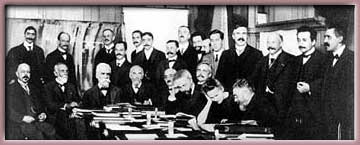 |
| Curie was
the only woman at the 1911conference organized and subsidized
by Belgian industrialist Ernest Solvay. Discussions at this
gathering of the world's top physicists opened the way to
a new physics that would bring together relativity, the quantum,
and radioactive atoms. Langevin, at far right, stands next
to the young Albert Einstein. Rutherford stands above Curie,
who confers with Poincaré. |
|
|
That autumn Curie,
Langevin, and some 20 other top physicists attended an international
conference in Brussels. While the scientists considered the challenge
to modern physics presented by the discovery of radioactivity, the
French press got hold of intimate letters that Curie and Langevin
had exchanged (or forgeries based on them).
 HE
WIDOW HAD TARNISHED
the good name of her deceased husband! This was only one of the accusations
hurled at Curie during her absence in Belgium. Resurrecting the lie
that she was Jewish, some anti-Semitic newspapers decried the devastation
wrought on a good Frenchwoman by a foreign Jewish home wrecker. Other
reporters spread false hints that Curie's affair with Langevin had
begun while Pierre was still alive, driving him to commit suicide
in despair. HE
WIDOW HAD TARNISHED
the good name of her deceased husband! This was only one of the accusations
hurled at Curie during her absence in Belgium. Resurrecting the lie
that she was Jewish, some anti-Semitic newspapers decried the devastation
wrought on a good Frenchwoman by a foreign Jewish home wrecker. Other
reporters spread false hints that Curie's affair with Langevin had
begun while Pierre was still alive, driving him to commit suicide
in despair.
“The fires of radium which beam
so mysteriously...have just lit a fire in the heart of one
of the scientists who studies their action so devotedly; and
the wife and the children of this scientist are in tears....”
--Le Journal, November 4, 1911
|
|
|
On her return to
France, Curie discovered an angry mob congregated in front of her
home in Sceaux, terrorizing 14-year-old Irène and 7-year-old Eve.
Curie and her daughters had to take refuge in the home of friends
in Paris. Meanwhile Langevin and a journalist who had reviled Marie
held a duel--an emotional but bloodless “affair of honor.”
|
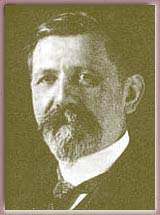 |
| Mathematician Emile Borel, scientific director
of the Ecole Normale Supérieure, sheltered Curie and her daughters
even when the minister of public instruction threatened to fire
him for sullying French academic honor. |
|
� 2000 -
American Institute of Physics
|

